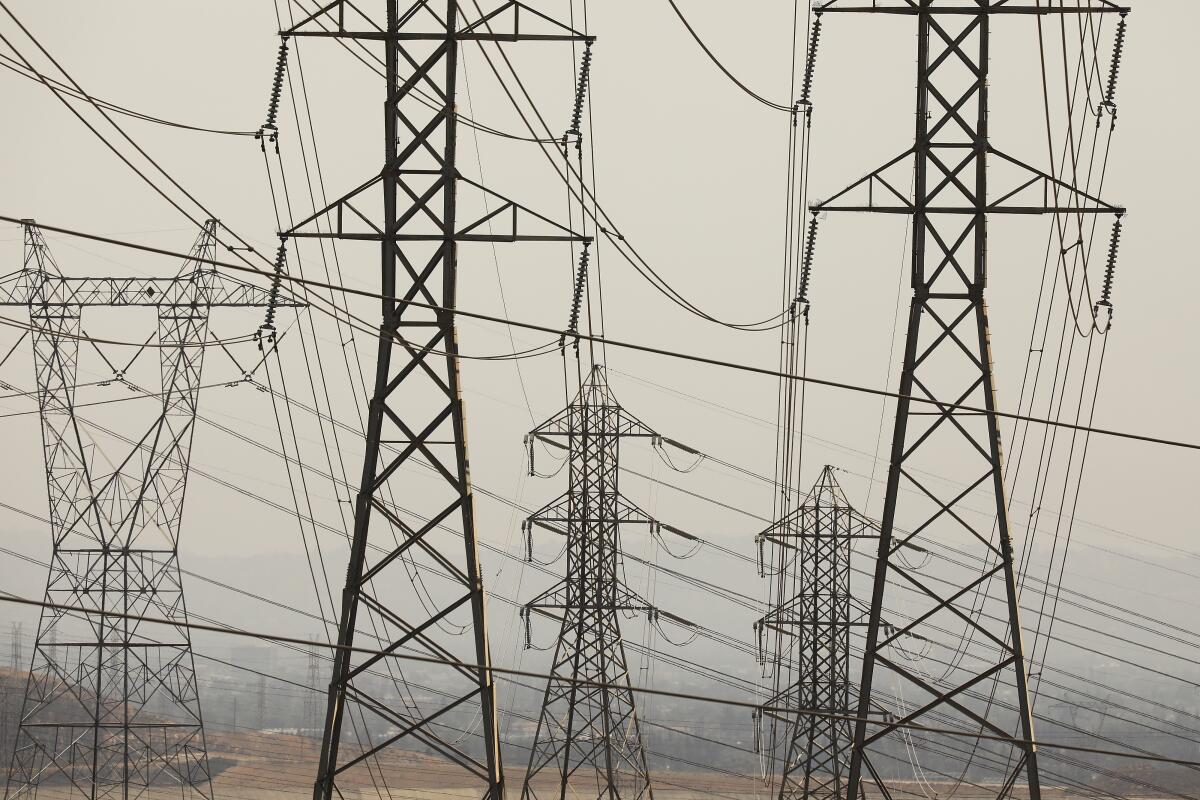Column: How you pay for electricity is changing. Here’s what you need to know

- Share via
More than 2 million Southern California Edison residential customers are about to be switched to new rate plans.
Approximately half this number will see their monthly bills go down, the utility says. A million or so may see their bills rise by a few bucks.
For the record:
11:24 a.m. Sept. 24, 2021An earlier version of this column incorrectly stated that Edison customers cannot change back to their previous rate plan after the first year. They can make once-a-year changes.
And roughly 100,000 Edison customers could see their electricity bills climb by hundreds of dollars a year unless they opt out or significantly change their behavior.
Californians are now facing one of the most sweeping changes to how they pay for energy. Ensuring ratepayers are well-informed about the stakes — and the decisions they have to make — is crucial. Edison could be doing a better job.
A spokesperson for the utility challenged that characterization. We’ll get back to that.
I learned about the Edison rate change from a Palm Springs resident named Lynn Pettit, who sent me a copy of the letter she received from the utility informing her about the transition, which in her case takes effect in December.
“Is it a scam?” she asked.
“I thought at first that the letter seemed reasonable,” Pettit, 85, told me. “Then I read the rest of it and I thought, ‘What?‘”
Coffee prices, and food costs in general, are rising because of climate change. For consumers, that’s a good reason to take this problem seriously.
OK, this next bit is a little wonky, so hang in there.
It won’t come as a news flash to anyone that California’s power grid is straining to keep up with demand as climate change affects electricity usage, especially during increasingly sizzling summers.
Crazy-hot temps mean millions of air conditioners running simultaneously. Blackouts are a perennial possibility.
To help fix this, the California Public Utilities Commission ordered Edison, Pacific Gas & Electric and San Diego Gas & Electric to switch most customers to so-called time-of-use rate plans.
The idea is to offer lower rates to people during off-peak hours. Basically, demand is highest between 4 p.m. and 9 p.m., when solar power is less plentiful and energy can cost about 60% more on summer weekdays.
Time-of-use plans allow most ratepayers to save money if they concentrate their energy use — running the washing machine, say — outside that time frame.
Edison has already moved about a million residential customers and most business customers to time-of-use plans. It’s now notifying 2.3 million more residential customers that it’s their turn, with rate changes occurring in waves from November to next April.
It may cost as little as $100 to manufacture a hearing aid. The list price is typically in the thousands of dollars (and not covered by most insurance).
Let’s stipulate right here that time-of-use rate plans are a good idea. They incentivize consumers to ease the burden on the power grid, make more use of alternative energy sources and generally be nicer to Mother Nature.
But if the letter received by Pettit is any indication, Edison could be doing a better job selling the concept.
“Time-of-use plans encourage people to use energy at the times of day when renewable energy, like solar and wind, is the most abundant and at the lowest cost,” it says.
“With small changes in your energy habits, you can save money and help our state meet its clean energy goals.”
Then comes the first curve ball. The letter says Pettit and other Edison customers will be moved automatically to time-of-use plans unless they opt out.
Let’s be real clear about this: Opt-outs are almost always a red flag for consumers. They typically signal that something is good for companies but bad for customers.
The sharing of your personal information, for instance. If you don’t want a company doing that, you have to opt out (and even then, businesses will still do it on a limited basis).
Companies are well aware that relatively few consumers will make the effort to opt out of things, which is why important decisions are routinely presented as opt-outs rather than opt-ins. Call it corporate coercion.
By the same token, though, many if not most consumers won’t opt in to things that they didn’t initiate. They’ll ignore the offer.
This is a Catch-22 of modern life. Opt-outs are often unfair. Opt-ins are frequently ineffective.
As Disney raises the price of its Hulu streaming service, analysts say consumers are growing pickier about which services they’ll subscribe to.
Edison’s letter to Pettit makes clear that the change to her rate plan is not in her favor. It states that, under her current plan, she pays about $4,467 a year for power.
Under the pending time-of-use plan, it says, she’ll pay $4,705 a year — a more than 5% rate hike.
The letter says that for the first 12 months after the switch, she’ll receive a one-time credit from Edison if her time-of-use bills exceed her current payments. It says she can switch back to her current plan during the first year. Once-a-year changes are also possible after this time.
“I wonder how many people won’t read the letter, or won’t check their bills on a regular basis,” Pettit told me. “The only reasonable way to do this is to ask people to opt in.”
Normally I’d agree with that. But in this case, the stakes are exceedingly high, and it’s crucial that as many Californians as possible participate in the new rate plan.
Ron Gales, an Edison spokesperson, said the Southern California utility and Northern California’s PG&E originally favored the idea of opt-ins when statewide plans for the switch to time-of-use rates started taking shape about a decade ago.
California regulators, however, saw that Sacramento’s community-owned utility had better luck with opt-outs, so the edict was handed down: Opt-outs for all.
From Edison’s perspective, this was the right move.
Gales told me that when the utility tested opt-ins with some customers, only about 5% agreed to switch to the new plan. That’s 95% who either didn’t want to change or couldn’t be bothered to even think about it.
“We’re trying to alter the behavior of millions of people,” Gales observed. “How do you do that if hardly anyone opts in?”
San Diego’s utility finished moving eligible residential customers to time-of-use rates in May 2020. According to the PUC, 98% of the total remained on the new plan.
Gales said most Edison customers will see lower bills as a result of moving to time-of-use plans and making modest changes to their energy use.
But he acknowledged that for about 100,000 “extreme non-benefitters” such as Pettit, average monthly bills could rise by as much as 10% from current levels.
“We recognize that,” he told me. “We’ll be following up with such people by phone.”
I pointed out that amid a proliferation of scam calls, many people no longer pick up the phone. “That’s a valid point,” Gales acknowledged — another quirk of modern life.
Where Edison dropped the ball, I think, is in making the case to the tens of thousands of people like Pettit who will look at their letters and conclude they’re being hit with a hefty rate increase.
Gales explained that the estimates for current payments versus time-of-use payments don’t factor in behavioral changes a customer might make.
That is, Pettit and others could still see their bills go down if they adjust their energy use to avoid peak hours.
Edison could have done a better job communicating this.
What it should have done is provide not two but three data points — estimated current bills, estimated time-of-use bills and estimated time-of-use bills with new behavior factored in.
Gales said Edison’s honchos considered estimating for people like Pettit how much their bills could decline if they adapted to time-of-use conditions. “We just didn’t have a lot of confidence in our numbers,” he conceded.
I said earlier this was wonky. Now you see why.
The bottom line for all Californians is that the changeover to time-of-use rates is a good thing and should help us better manage our energy resources, especially on hot summer days.
Edison could have explained this better. It should have explained this better.
But now you know.
More to Read
Inside the business of entertainment
The Wide Shot brings you news, analysis and insights on everything from streaming wars to production — and what it all means for the future.
You may occasionally receive promotional content from the Los Angeles Times.














